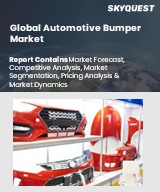
Report ID: SQMIG25A2243

Report ID:
SQMIG25A2243 |
Region:
Global |
Published Date: April, 2024
Pages:
225
|
Tables:
86 |
Figures:
76
Automotive Bumper Market size was valued at USD 12.63 Billion in 2023 and is poised to grow from USD 13.07 Billion in 2024 to USD 17.21 Billion by 2032, growing at a CAGR of 3.5% during the forecast period (2025-2032).
The automotive industry is witnessing significant changes driven by technological advances, safety regulations and consumer preferences. These factors affect the design, materials and performance of automotive bumpers. Strict safety regulations put in place by governments and regulatory agencies around the world are forcing automakers to equip their vehicles with advanced safety features. Bumpers play an important role in providing traction and protection to vehicles during collisions, leading to a high demand for technologically advanced and durable bumpers. With increasing emphasis on fuel efficiency and environmental sustainability, automakers are adopting lightweight materials such as composite plastics, carbon fiber and aluminum for bumpers. A lightweight bumper helps to reduce the vehicle’s overall weight, improve fuel efficiency and reduce emissions. Vehicle bumpers enhance vehicle safety and driving assistance features by integrating advanced technologies such as sensors, cameras and radar systems Bumpers with integrated sensors and cameras make it easier to assist vehicles in parking lots, accident avoidance and adaptive cruise control systems, drive the market growth.
Our industry expert will work with you to provide you with customized data in a short amount of time.
REQUEST FREE CUSTOMIZATIONWant to customize this report? This report can be personalized according to your needs. Our analysts and industry experts will work directly with you to understand your requirements and provide you with customized data in a short amount of time. We offer $1000 worth of FREE customization at the time of purchase.

Report ID: SQMIG25A2243